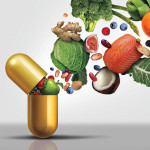For people living with HIV, weight loss was once widely considered a precursor of one of the virus’s most dreaded effects: AIDS-related wasting. But a study of HIV-positive naval personnel presented last October at the Infectious Diseases Society of America’s annual meeting in San Diego found that nearly two thirds of those surveyed were overweight or obese. Indeed, with summer rapidly approaching, plenty of people with HIV are doing exactly what the rest of the world does at this time of year—looking forward to weekends at the beach, while wondering if they’ll fit into last year’s bathing suit.
Deciding which of the dozens of diet books to trust isn’t easy: Should you go low-carb, low-fat, both or neither? And if the contradictions weren’t confusing enough, almost none of the dietary guides—or the research behind them—speak to the nutritional needs of people living with HIV.
So just how does a person living with HIV choose the safest and most effective way of losing extra pounds? For answers, we turned to two registered dieticians with expertise tackling nutritional challenges in HIV-positive people. And though their healthful tips stress balance and moderation, they also know a thing or two about flavor.
Low-Carb Conflict
Since the 1960s, nutrition experts from the United States Department of Agriculture (USDA) have recommended that more than half of our daily caloric intake consist of carbohydrates—foods that can be broken down into energy-producing sugar. Though the experts have suggested most of this dietary energy come from fruits and whole grains—as opposed to refined sugary foods like ice cream or candy—carbohydrates were thought to be the foundation of any healthy diet. And with an eye toward staying slender and warding off heart disease, the USDA advises that the consumption of fats, particularly saturated animal fats, be kept to a minimum.
Not all experts, however, agreed with these recommendations. Cardiologists Robert Atkins, MD, and Arthur Agatston, MD, challenged traditional thinking and masterminded two well-known weight-loss strategies: the Atkins Nutritional Approach and the South Beach Diet, respectively. While these regimens, which gained immense popularity earlier this decade, differ somewhat, both insist that diets rich in carbohydrates, not fats, are responsible for thickening waistlines and worsening health. When we’re deprived of carbohydrates, Atkins and Agatston argue, our bodies instead consume the fats and proteins stored in our tissue to provide cells with the energy they need. And so fat deposits begin to diminish, leading to slimming and weight loss.
However, the fact that low-carb diets force your body to burn its stores of fat and tissue could make them dangerous options for people living with HIV, particularly African Americans and Latinos. Cade Fields-Gardner, a registered dietician with The Cutting Edge, an HIV and nutrition consulting group near Chicago, says, “[Eating too much protein and too few carbohydrates] can cause stress and strain to the kidneys…and we try to keep [African Americans and Hispanics] away from low-carbohydrate diets, because the rate of kidney problems is really much more common.” She points out that some HIV medicines also carry the risk of kidney problems, so people taking those meds should be extra careful of low-carb diets.
Other criticisms of low-carb diets—notably the Atkins Diet, which is less restrictive of saturated animal fats than the South Beach Diet—argue that they can increase both cholesterol levels and the risk of cardiovascular disease, which is already a concern for people with HIV who take antiretrovirals known to increase lipid levels. But recent research suggests otherwise. Jennifer Sachs, a registered dietician at the University of California San Diego Medical Center, confirms that not only have lower-carb diets been associated with more weight loss compared with low-fat diet plans, but also had greater healthful impacts on cholesterol and triglyceride levels.
But Sachs points out that no one diet has all the answers. For one thing, she says, in most of the studies conducted so far, the average weight loss from any diet has been minimal (roughly ten pounds or less in a year). And a recent study of four different diets, including the Atkins diet, showed just how hard it is to follow them, even for the people in the clinical trial. “When you look at those assigned to follow the Atkins diet”—in terms of what they actually ate—“they were following a much higher carbohydrate diet than what the Atkins tells you to,” says Sachs.
Slimming Safely
So what are the best diet options for people living with HIV? Sachs and Fields-Gardner recommend the Mediterranean diet, which stresses healthy fats—from the fish, nuts and olive oil common to the region—plus lean protein combined with carbohydrates that come mostly from whole grains. Fields-Gardner points out that the heart of any effective diet is consuming fewer calories than your body burns each day, and that regular exercise greatly increases the chance of short- and long-term weight loss.
There’s also hope for people who primarily carry their extra weight in the gut, a common concern among many people with HIV. Sachs and Field-Gardner point to studies involving pre-diabetic HIV-negative volunteers with gut-fat accumulation. According to the research, diets high in fiber—found mostly in whole grains, vegetables and fruits—helped them lose stubborn belly fat.
Both diet experts warn against rapid weight loss and the almost inevitable yo-yo effect that comes with it. As tempting as it may be to try to lose 30 pounds by Memorial Day, Sachs cautions that the winners in the diet race are those who lose weight gradually—no more than about three pounds a week. While this may not get you in swimsuit shape by the beginning of summer, it will help ensure that once you get in great shape, you’ll stay that way.
Slim for Summer: Safe and Sane Weight Loss






6 Comments
6 Comments